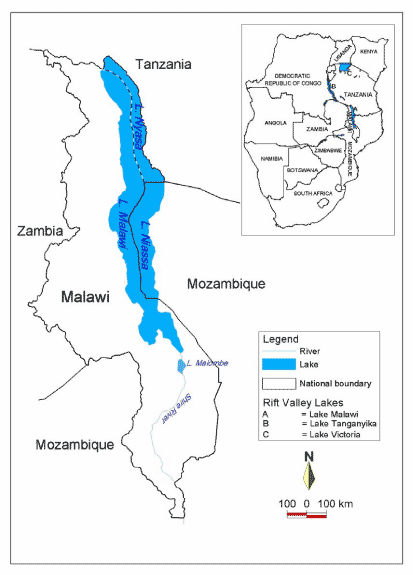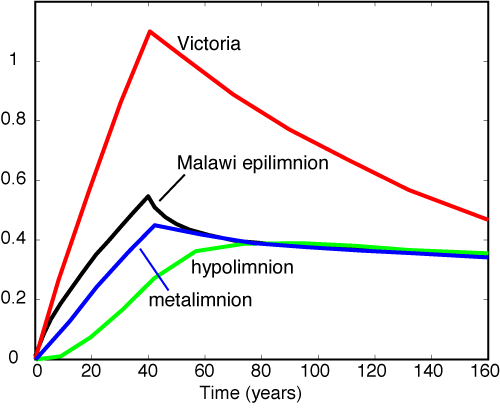


 |  |  | 20.1 Introduction |
The Great lakes of east Africa have similar characteristics. They are perhaps the best-known lakes in the world for their faunal diversity. From a limnological perspective, the distinguishing attributes of these lakes are their large size and tropical location. Their diversity may be attributed to these features, along with their great age, e.g. Lake Malawi has existed in the rift valley for over two million years [59][217]. Despite their shared characteristics, there are some major limnological differences among Africa's three largest lakes. Compared to Lake Malawi and Tanganyika, Lake Victoria is substantially shallower, younger geologically and has faster water renewal times [217][52]. Lake Malawi and Tanganyika are similar in morphology and transparency, and are both meromictic, but they are markedly different with regard to hydrology, nutrient dynamics [219], plankton composition [223], and trophic structure [217]. In contrast to Lake Tanganyika, Lake Malawi consists of a single basin with the greatest depth of about 785 m (Table 1). Lake Malawi is about 560 km long and greatest width of about 75 km. It is about 1/3 of the total geographical area of the country (Figure 1). Nearly 25% of Lake Malawi belongs to Mozambique and they call it Lake Niassa. In Tanzania Lake Malawi is still called its colonial name, Lake Nyasa (Figure 1). Victoria is the largest lake by area in Africa (second largest in the world) but with only one-third the volume of that of Lake Malawi (Table 1). Lake Tanganyika is the deepest of these three East African Great Lakes and has the biggest volume of about 18,900 km3 (Table 1). The effects of the anthropogenic activities on these lakes may be quite different.

| Malawi | Tanganyika | Victoria | |
| Catchment Area (km2) | 100,500f | 220,000 f | 195,000 f |
| Lake Area (km2) | 28,000 f | 32,600 f | 68,800 f |
| Maximum Depth (m) | 785a | 1470a | 79a |
| Mean Depth (m) | 292a | 580a | 40 f |
| Volume (km3) | 8,400a | 18,900a | 2,760b |
| Outflow (O) (km3 y-1) | 11c | 2,7d | 20b |
| Inflow (I) (km3 y-1) | 29c | 14d | 20b |
| Precipitation (P) (km3 y-1) | 39c | 29d | 100b |
| Evaporation (km3 y-1) | 55e | 44d | 100b |
| Flushing time (V/O) (years) | 750 f | 7,000 f | 140 f |
| Residence time (V/(P+1) (years) | 140 f | 440 f | 23 f |
Such benefits may perish with the current human activities, which are already threatening these values. In Lake Victoria it is likely that hundreds of haplochromine cichlids have gone extinct in the past decade. Only three species are currently harvested in any numbers [218]. The loss of this trophically diverse group of fishes and reduction to extreme trophic simplicity can be a hypothesis to explain other change in the food web. For example, eutrophication is likely to be considered as one of the effects due to such trophic changes.

Human activities that threaten the lakes include agriculture, urban development, tourism, industrial development, over-fishing, and other human activities in the catchments and alien species introduction. Of special concern are the possible oil exploration activities in Lake Malawi and Tanganyika. However, other phenomena, especially the increase in human and livestock population since the colonialism and following state development, must also be considered. This development together with anticipated sensitivity to eutrophication of the tropical Great Lakes because of their `endless summer', warm deep water and dominance of direct precipitation in their water budget [219] must be carefully considered.
 |  |  | 20.1 Introduction |